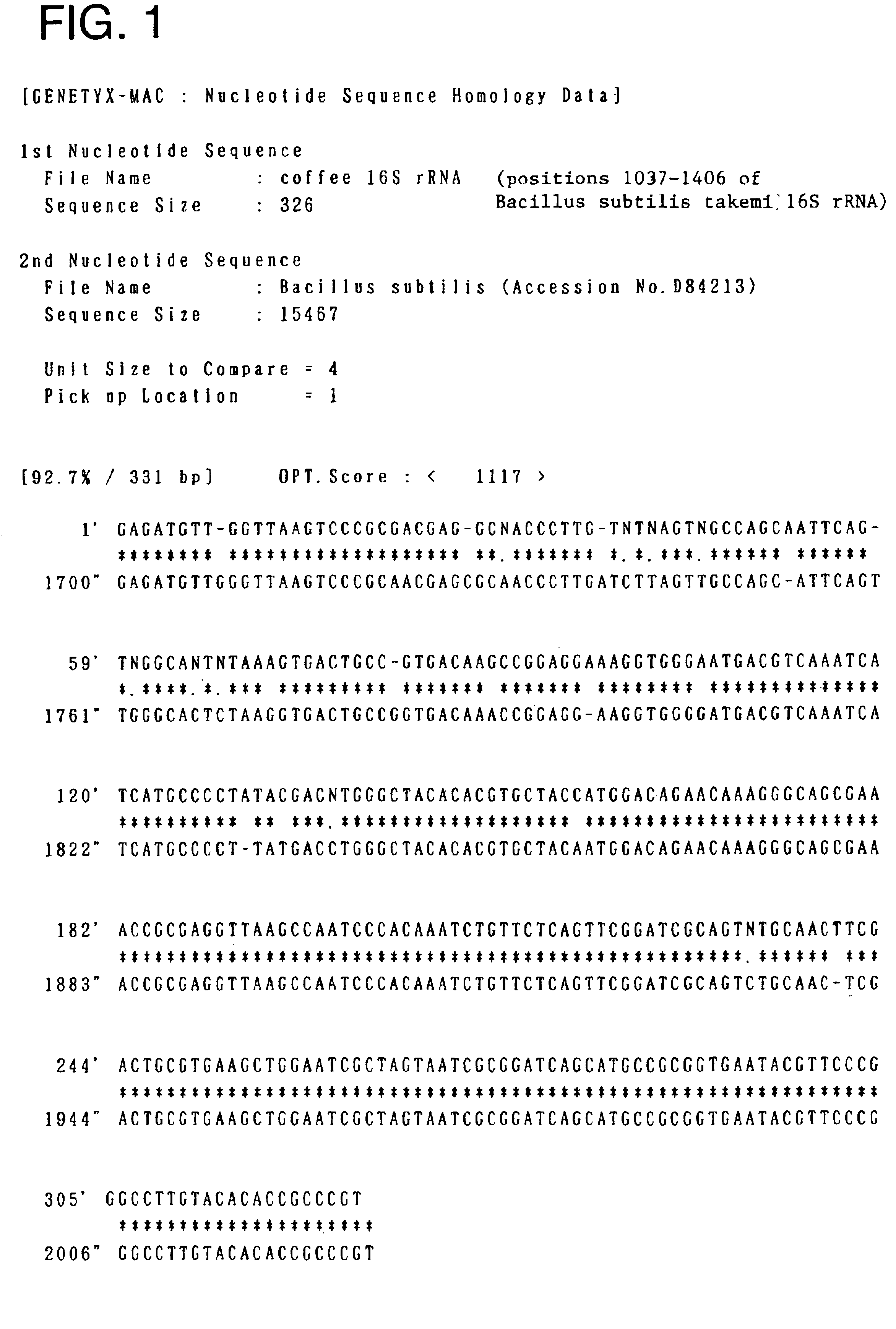Bacillus subtilis takemi and compositions thereof
a technology of takemi and bacillus subtilis, applied in the field of takemi, can solve the problems of offensive odor caused, bad odor generated by degradation and putrefactive microorganisms, and big social problems
- Summary
- Abstract
- Description
- Claims
- Application Information
AI Technical Summary
Benefits of technology
Problems solved by technology
Method used
Image
Examples
example 1
Quantitative Determination of Chitin / Chitosan
1. Samples
1) Bacillus subtilis takemi
2) Bacillus subtilis nattoh
2. Outline of the Test
Each sample was treated with alkali as described below to obtain insoluble matter, which was subjected to acid hydrolysis and then high performance liquid chromatography to determine the amount of glucosamine. This amount was converted into the amount of chitin (or chitosan).
3. Test Results
The results are shown in Table 6.
4. Testing Method
1) Alkali Treatment
About 5 g of the sample was weighed accurately. Five milliliters of 8% (w / v) sodium hydroxide solution was added thereto, and the resultant mixture was heated for 2 hours in boiling water bath. After cooled to room temperature, the mixture was vacuum filtered with a membrane filter (0.45 .mu.m). The residue was washed with water until the filtrate became neutral.
The residue was dried overnight at 60.degree. C. together with the membrane filter. Then, the residue was transferred into ...
example 2
Preparation of a Composition for Soil Improvement
A granule-type inorganic porous ceramic that releases 88 kinds of anions and cations was provided (product name: Z Gold; manufactured by Gold Kousan Co., Ltd.). To 1,200 ml of an aqueous solution containing 120 g of glucose and 60 g of yeast extract, 3 kg of the above inorganic, porous ceramic granules was added and agitated thoroughly. To this mixture, 300 ml of a liquid containing Bacillus subtilis takemi at 1.times.10.sup.8 cells / ml was added and agitated. The resultant dispersion mixture was maintained at 25-45.degree. C. to thereby grow the microorganism in the pores of the porous ceramic.
The resultant ceramic granules were powdered, and then mixed with an organic fertilizer material consisting of 200 kg of rape seed meals, 200 kg of bone dust, 150 kg of fish cake, 150 kg of rice bran, 100 kg of soybean powder, 100 kg of poultry droppings and 100 kg of seaweed compost. This mixture was fermented for about 30 days. As the fermenta...
example 3
Tomato Cultivation Using the Composition for Soil Improvement
Tomato is a representative vegetable that dislikes continuous cropping. Damage by continuous cropping is believed to occur because of the following reasons. Briefly, as a result of abundant application of agricultural chemicals and fertilizers, root hairs of plants are burnt and become incapable of absorbing phosphor and minerals; useful microorganisms in soil are killed and thus the food-chain between useful microorganisms and plants is inhibited; and harmful microorganisms propagate to cause diseases.
Thirty to thirty-five bags of the composition for soil improvement (prepared in Example 2 above) (15 kg / bag) was applied per 10 a. of tomato cultivating field.
As a result, tomato plants grown up there had appropriate heights and were sturdy with short internodes. Usually, flower bud growth tends to become unfavorable at the 3rd and 4th branch joints. However, such a problem was not observed in the tomato plants grown in this...
PUM
 Login to View More
Login to View More Abstract
Description
Claims
Application Information
 Login to View More
Login to View More - R&D
- Intellectual Property
- Life Sciences
- Materials
- Tech Scout
- Unparalleled Data Quality
- Higher Quality Content
- 60% Fewer Hallucinations
Browse by: Latest US Patents, China's latest patents, Technical Efficacy Thesaurus, Application Domain, Technology Topic, Popular Technical Reports.
© 2025 PatSnap. All rights reserved.Legal|Privacy policy|Modern Slavery Act Transparency Statement|Sitemap|About US| Contact US: help@patsnap.com

